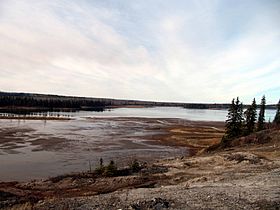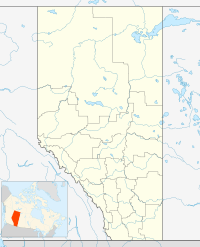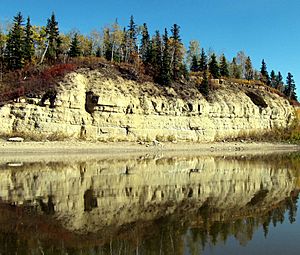La Saline Natural Area facts for kids
Quick facts for kids La Saline Natural Area |
|
|---|---|

Saline Lake and salt marshes at La Saline Natural Area, seen from the edge of the tufa mound on the southeastern shore
|
|
| Location | Wood Buffalo, Alberta, Canada |
| Nearest city | Fort McMurray |
| Area | 331.0 ha (818 acres) |
| Governing body | Alberta Tourism, Parks and Recreation |
La Saline Natural Area is a special place in the boreal forest of northeastern Alberta, Canada. It protects Saline Lake, which is a unique salty lake. This lake is an oxbow lake, meaning it was once part of the Athabasca River but got cut off. It's located north of Fort McMurray.
Saline Lake is super important for waterfowl and other birds. They stop here during their long journeys along the Athabasca River. You can also find cool rock formations called tufa around the salt springs on the lake's southeastern shore.
Wildlife and Plants

Saline Lake is the best lake in the area for waterfowl. Many people enjoy birdwatching here. Thousands of ducks, geese, and other birds fly along the Athabasca River. They are heading to their nesting spots on the Peace–Athabasca Delta. Saline Lake is a key resting and feeding spot for them.
Some birds, like coots, mallards, widgeons, buffleheads, and green-winged teal, even build their nests right on Saline Lake. The lake is also vital for migrating shore birds. These birds eat tiny creatures like Daphnia and other small invertebrates. These little animals are plentiful in the lake's salty water during summer.
The salt springs create natural mineral licks. These licks attract animals like moose and deer. They come to the lake to get important minerals.
La Saline Natural Area is part of the Boreal Forest – Central Mixedwood Region in Alberta. You can find rare plants that love super salty conditions on the tufa mound. There are also special plant groups that grow in the brackish (slightly salty) and saline marshes along the lake's edge.
How the Land Was Formed
La Saline Natural Area is in the middle of the Athabasca Oil Sands region. The water in the springs at La Saline comes from very old rock layers deep underground. These layers formed during the Devonian period, millions of years ago. They include carbonate rocks and rock salt deposits.
As water flows through these rocks, it picks up dissolved carbonate and evaporite minerals. The spring water at La Saline is very salty, with lots of dissolved solids. It comes to the surface because it hits a layer of bitumen-filled sands. This layer stops the water from going deeper.
When the water reaches the surface, carbon dioxide and a little bit of hydrogen sulfide gas are released. This causes some of the dissolved minerals to form solid rock. This process creates the tufa. Scientists have found minerals like calcite, dolomite, quartz, and gypsum in the tufa. Large tufa deposits, including a mound about 3 meters (10 feet) wide, have built up around the salt springs on the lake's southeastern shore.
You can also see outcrops of Devonian limestone along the Athabasca River. These rocks contain fossils of ancient sea creatures. You might find brachiopods, snails, stromatoporoids, and crinoid remains.
Getting There
There are no roads or marked trails to La Saline Natural Area. The easiest way to reach it is by traveling along the Athabasca River.



